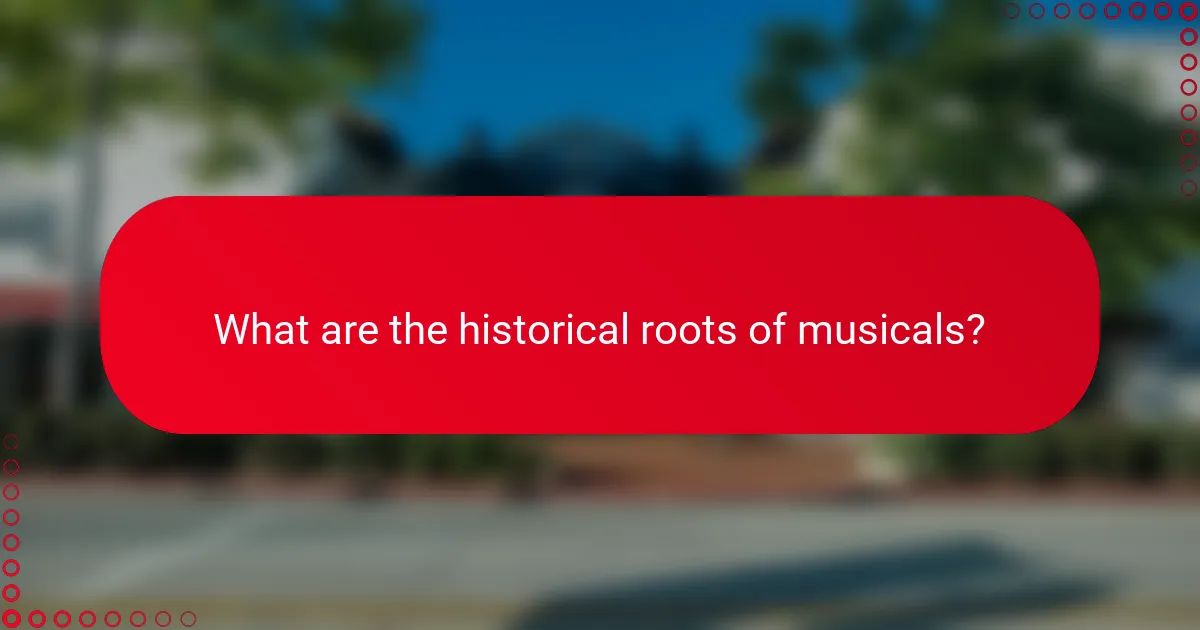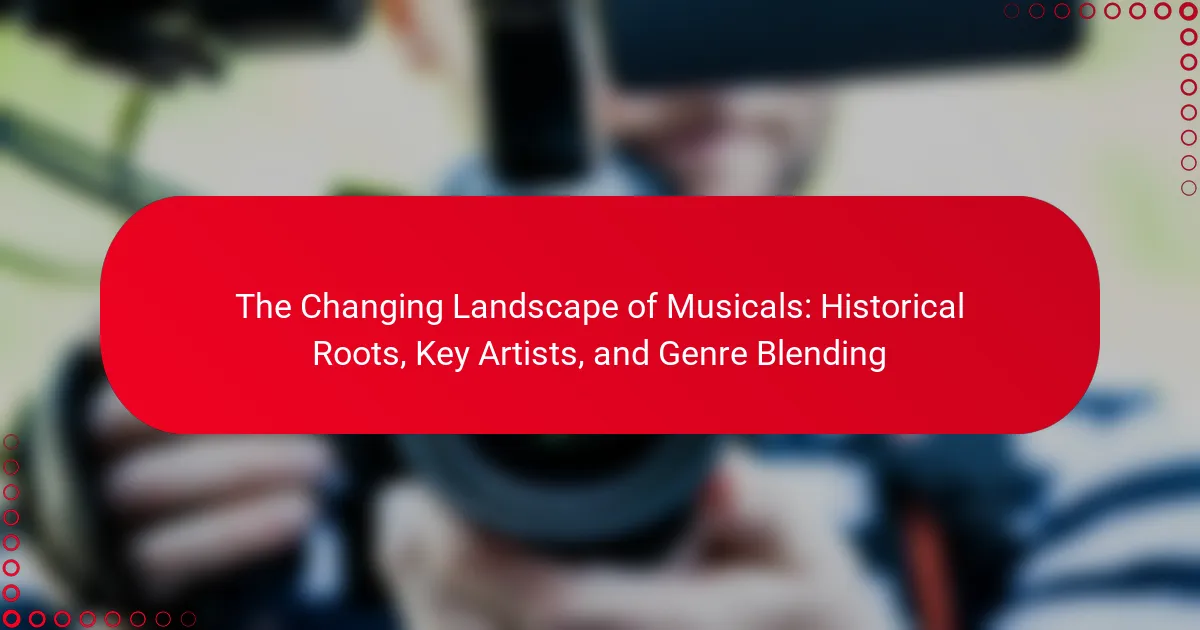The article explores the changing landscape of musicals, tracing their historical roots from ancient Greece to modern Broadway. It highlights key artists such as Stephen Sondheim, Andrew Lloyd Webber, and Lin-Manuel Miranda, who have significantly influenced the genre through innovative storytelling and diverse musical styles. The discussion includes the impact of genre blending, showcasing how productions like “Hamilton” and “In the Heights” integrate various musical elements to appeal to contemporary audiences. This evolution emphasizes the dynamic nature of musicals as they adapt to cultural shifts and enhance emotional depth in storytelling.

What are the historical roots of musicals?
Musicals have historical roots tracing back to ancient theatrical traditions. The origins can be found in ancient Greece, where plays included music and dance. These performances were often part of religious festivals. The Roman Empire continued this tradition with theatrical performances that incorporated music. In the Middle Ages, liturgical dramas featured songs and were performed in churches. The Renaissance saw the rise of opera, blending music and storytelling. By the 19th century, the development of vaudeville and operetta further shaped the musical form. Broadway emerged in the early 20th century as a hub for modern musicals. Each of these stages contributed to the evolution of the musical as a distinct genre.
How did musicals evolve from early theatrical forms?
Musicals evolved from early theatrical forms by integrating music, dance, and dialogue. Early forms like opera and vaudeville laid the groundwork for this evolution. The introduction of song and dance into storytelling became prominent in the 19th century. The first modern musical is often credited to “Show Boat” in 1927. This production combined narrative and musical elements seamlessly. The Golden Age of Musicals followed, featuring composers like Rodgers and Hammerstein. Their works emphasized character development through song. Over time, musicals incorporated diverse genres and styles, reflecting cultural changes. This evolution continues to shape contemporary musical theater today.
What influences shaped the development of musicals in the 19th century?
The development of musicals in the 19th century was shaped by various cultural, social, and technological influences. The rise of vaudeville and operetta provided a framework for musical storytelling. The Industrial Revolution increased urbanization, leading to a demand for entertainment in cities. The popularity of minstrel shows highlighted racial themes and musical styles. Advances in theater technology improved staging and sound, enhancing audience experiences. Additionally, the influence of European operas and Broadway’s emergence began to blend different musical genres. These factors collectively transformed musicals into a significant form of entertainment by the century’s end.
How did the advent of sound in film impact the musical genre?
The advent of sound in film revolutionized the musical genre significantly. It allowed for synchronized music and dialogue, enhancing storytelling. The first sound film, “The Jazz Singer,” released in 1927, marked a pivotal moment. This film integrated songs into the narrative, setting a precedent for future musicals. As a result, musicals began to flourish in Hollywood during the late 1920s and 1930s. The ability to record and amplify sound transformed production techniques. Filmmakers could now create elaborate musical numbers. This innovation also expanded audience engagement, as viewers connected with the music emotionally. Overall, sound in film solidified the musical genre’s popularity and artistic expression.
What are the key milestones in musical history?
The key milestones in musical history include the development of early music notation, the emergence of opera, and the birth of jazz. Early music notation, established around the 9th century, allowed composers to document their works. The first opera, “Dafne,” was composed in 1598, marking the start of a new genre. The 18th century saw the rise of classical music, with composers like Bach and Mozart influencing the art form. The 20th century introduced jazz, which blended African and European musical traditions. Rock and roll emerged in the 1950s, revolutionizing popular music. The digital age brought music production and distribution into a new era, impacting how music is consumed and created. Each milestone reflects significant cultural and technological shifts in the musical landscape.
Which productions marked significant turning points in musical theater?
“Show Boat” marked a significant turning point in musical theater. It was the first musical to integrate songs with a coherent narrative. Premiering in 1927, it addressed serious social issues such as racism and class disparity. “Oklahoma!” followed in 1943, further solidifying the narrative-driven musical format. This production introduced the concept of the “book musical,” where songs advance the plot. “West Side Story” in 1957 showcased a blend of classical music and contemporary themes. It highlighted the potential of dance as a storytelling medium. “Hair,” which debuted in 1968, broke conventions by introducing rock music and counterculture themes. These productions collectively reshaped the landscape of musical theater.
How did societal changes influence musical themes and styles?
Societal changes have significantly influenced musical themes and styles throughout history. For instance, the Civil Rights Movement in the 1960s led to the emergence of protest songs that addressed social justice. Similarly, the feminist movement inspired musical themes focused on women’s rights and empowerment. Economic shifts, such as the Great Depression, resulted in music that reflected hardship and resilience, notably in folk and blues genres. Additionally, technological advancements, like the advent of the internet, have diversified musical styles and distribution methods. These changes demonstrate how music adapts to reflect the prevailing social climate, making it a powerful medium for expression and connection.

Who are the key artists that shaped the musical landscape?
Key artists that shaped the musical landscape include Stephen Sondheim, Andrew Lloyd Webber, and Lin-Manuel Miranda. Stephen Sondheim revolutionized musical theatre with complex lyrics and innovative narratives. His works, such as “Sweeney Todd” and “Into the Woods,” redefined storytelling in musicals. Andrew Lloyd Webber is known for his blockbuster musicals like “The Phantom of the Opera” and “Cats,” which combined pop and classical music elements. Lin-Manuel Miranda gained acclaim for “Hamilton,” which blended hip-hop with traditional musical styles, attracting a diverse audience. These artists significantly influenced the evolution and popularity of musicals across different generations.
What contributions have iconic composers made to musicals?
Iconic composers have significantly shaped the landscape of musicals. They create memorable melodies that enhance storytelling. Their compositions often define the emotional tone of a production. Composers like Stephen Sondheim introduced complex lyrics and innovative structures. Andrew Lloyd Webber popularized the rock musical genre with works like “[censured] Superstar.” Leonard Bernstein blended classical music with jazz in “West Side Story.” These contributions have elevated musicals to a respected art form. Their influence can be seen in the evolution of musical theater styles over the decades.
How did Stephen Sondheim redefine musical storytelling?
Stephen Sondheim redefined musical storytelling by integrating complex characters and intricate narratives. He emphasized character development over plot, allowing deeper emotional connections. Sondheim’s lyrics often conveyed subtext and irony, enhancing the storytelling experience. His work in shows like “Sweeney Todd” and “Into the Woods” showcased non-linear narratives. He introduced motifs and themes that resonated throughout his musicals. This approach changed audience expectations for depth and complexity in musicals. Sondheim’s innovative use of music and lyrics created a new standard for storytelling in the genre. His influence is evident in contemporary musical theater, where character-driven narratives prevail.
What role did Andrew Lloyd Webber play in popularizing musicals?
Andrew Lloyd Webber significantly contributed to the popularization of musicals. He created iconic works such as “The Phantom of the Opera,” “Cats,” and “Evita.” These productions achieved global acclaim and commercial success. His innovative use of music and storytelling captivated audiences. Webber’s musicals often featured memorable melodies and elaborate staging. He also pioneered the concept of the “mega-musical,” which emphasized spectacle and production value. His influence helped elevate musicals to mainstream entertainment. Webber’s works have garnered numerous awards, including several Tony Awards and an Oscar. This recognition further solidified his role in shaping the musical theatre landscape.
Which performers have left a lasting impact on musical theater?
Broadway performers such as Ethel Merman, Leonard Bernstein, and Lin-Manuel Miranda have left a lasting impact on musical theater. Ethel Merman was known for her powerful voice and roles in classics like “Annie Get Your Gun.” Leonard Bernstein revolutionized the genre with his work on “West Side Story,” blending classical music with jazz influences. Lin-Manuel Miranda changed the landscape with “Hamilton,” incorporating hip-hop into storytelling. These performers have shaped the evolution of musical theater through their innovative contributions and memorable performances.
How did legends like Ethel Merman and Bernadette Peters influence the genre?
Ethel Merman and Bernadette Peters significantly influenced the musical genre through their powerful vocal techniques and unique interpretations. Merman’s robust voice and commanding stage presence helped define the American musical theatre sound in the mid-20th century. Her performances in shows like “Annie Get Your Gun” set a standard for vocal strength and character portrayal. Bernadette Peters brought a nuanced emotional depth to her roles, particularly in “Into the Woods” and “Song and Dance.” Her ability to convey complex emotions through song expanded the expressive range of musical theatre. Both artists contributed to the evolution of character-driven narratives in musicals, influencing subsequent generations of performers. Their legacies continue to inspire and shape the genre today.
What contemporary artists are reshaping the musical scene today?
Contemporary artists reshaping the musical scene today include Lin-Manuel Miranda, Billie Eilish, and Hozier. Lin-Manuel Miranda is known for his groundbreaking work on “Hamilton,” which blends hip-hop with traditional musical theater. Billie Eilish has transformed pop music with her unique sound and introspective lyrics. Hozier combines elements of folk, blues, and rock, bringing a fresh perspective to contemporary music. These artists are influencing genres and expanding the boundaries of musical expression. Their innovative approaches have garnered critical acclaim and a strong following, demonstrating their impact on the current musical landscape.

How has genre blending transformed musicals?
Genre blending has transformed musicals by incorporating diverse musical styles and storytelling techniques. This fusion allows for innovative narratives that resonate with wider audiences. For example, productions like “Hamilton” blend hip-hop with traditional musical elements. This approach attracts younger viewers and expands the genre’s appeal. Additionally, shows like “In the Heights” merge Latin music with Broadway, reflecting multicultural influences. The result is a dynamic art form that evolves with contemporary culture. Genre blending enhances emotional depth and character development, making stories more relatable. Overall, it revitalizes the musical landscape, creating fresh experiences for audiences.
What are the different genres that have influenced modern musicals?
Modern musicals have been influenced by various genres. These include jazz, which introduced improvisation and rhythmic complexity. Rock music has brought energy and youth culture into the narrative. Pop music has made musicals more accessible and relatable to wider audiences. Classical music has provided structure and orchestration techniques. Folk music has added storytelling elements and cultural authenticity. Musical theatre itself has evolved from operetta, blending spoken dialogue with songs. Additionally, hip-hop has emerged as a powerful narrative tool in recent productions. Each genre contributes unique elements that shape the contemporary musical landscape.
How has rock music integrated into traditional musical formats?
Rock music has integrated into traditional musical formats through various adaptations and collaborations. This genre has influenced theatrical productions by incorporating rock elements into scores. Notable musicals like “Hair” and “Rent” prominently feature rock music. These productions blend narrative storytelling with rock’s energetic rhythms and themes. Additionally, rock artists have collaborated with Broadway composers to create hybrid works. The fusion of rock and traditional musical styles has expanded audience appeal. This integration reflects changing cultural trends and musical tastes. The success of these musicals demonstrates rock’s enduring impact on the theatrical landscape.
What role does hip-hop play in contemporary musical narratives?
Hip-hop serves as a vital narrative tool in contemporary music. It provides a platform for storytelling that reflects social issues and personal experiences. Artists use hip-hop to address themes like identity, inequality, and resilience. The genre’s rhythmic and lyrical complexity enhances emotional expression. Collaborative projects often blend hip-hop with other musical styles, expanding its reach. For example, Broadway musicals like “Hamilton” integrate hip-hop to convey historical narratives. This fusion attracts diverse audiences and revitalizes traditional storytelling methods. Overall, hip-hop enriches contemporary musical narratives by making them more relatable and impactful.
How does genre blending enhance storytelling in musicals?
Genre blending enhances storytelling in musicals by combining different musical styles to create a richer narrative experience. This technique allows for diverse emotional expressions. For example, a musical might blend rock with classical elements to convey conflict and resolution effectively. The fusion of genres can also attract a wider audience. It engages various demographic groups by incorporating familiar sounds. Additionally, genre blending can highlight character development and thematic depth. Musicals like “Hamilton” showcase this by merging hip-hop with traditional show tunes. Such innovation can lead to critical acclaim and commercial success. This approach reflects the evolving nature of musical theatre.
What are examples of successful genre-blending musicals?
Successful genre-blending musicals include “Hamilton,” “Rent,” and “The Lion King.” “Hamilton” combines hip-hop, R&B, and traditional musical styles. It has received critical acclaim and numerous awards, including the Pulitzer Prize for Drama. “Rent” merges rock music with traditional musical theater elements. It addresses themes of love and social issues, resonating with audiences since its debut in 1996. “The Lion King” blends African music and rhythms with Western musical theater. It has become one of the highest-grossing musicals of all time, showcasing the effectiveness of genre blending in storytelling.
How do audiences respond to innovative musical styles?
Audiences often respond positively to innovative musical styles. They demonstrate excitement and curiosity towards new sounds and concepts. This engagement can lead to increased attendance at performances. Historical data shows that groundbreaking musicals, like “Hamilton,” attracted diverse audiences. These productions often challenge traditional norms and encourage discussions. Audience reactions can include social media buzz and critical acclaim. Innovative styles can also influence mainstream music trends. Overall, audiences appreciate creativity and originality in musical presentations.
What trends can we expect in the future of musicals?
Future musicals will increasingly incorporate technology and multimedia elements. Virtual reality and augmented reality are becoming common in performances. This trend enhances audience engagement and creates immersive experiences. Additionally, diverse storytelling will gain more prominence. Musicals will explore a wider range of cultural narratives and perspectives. This shift reflects society’s growing emphasis on inclusivity. Original scores and contemporary music styles will also be prevalent. Genres like hip-hop and electronic music are being integrated into traditional formats. Furthermore, streaming platforms will influence how musicals are produced and consumed. This shift allows for broader access to performances. Overall, these trends indicate a dynamic evolution in the musical landscape.
How are technology and digital media influencing musical productions?
Technology and digital media are significantly transforming musical productions. They enable new methods of composition and collaboration. Digital audio workstations (DAWs) allow artists to create music from anywhere. This flexibility has led to a surge in independent productions. Streaming platforms facilitate immediate access to music, reshaping distribution models. Additionally, social media platforms help artists connect with audiences directly. Virtual reality and augmented reality are introducing immersive experiences in performances. These advancements are making musical productions more accessible and innovative.
What best practices should aspiring musical creators consider?
Aspiring musical creators should focus on collaboration, originality, and continuous learning. Collaborating with other artists can lead to innovative ideas and diverse perspectives. Originality in songwriting helps to create a unique voice in a competitive industry. Continuous learning through workshops and courses enhances skills and keeps creators updated with industry trends. Networking with industry professionals can open doors for opportunities. Additionally, seeking feedback from peers and mentors can provide valuable insights for improvement. Embracing technology for music production and distribution is essential in today’s digital age. These practices are supported by successful artists who emphasize the importance of collaboration and innovation in their careers.
The main entity of the article is musicals, which have evolved significantly over time through various historical roots and cultural influences. The article explores the origins of musicals from ancient Greece to modern-day Broadway, highlighting key milestones and influential figures such as Stephen Sondheim and Andrew Lloyd Webber. It also examines the impact of genre blending, particularly how elements like rock and hip-hop have reshaped musical narratives, and discusses future trends influenced by technology and digital media. Overall, the article provides a comprehensive overview of the changing landscape of musicals, focusing on their historical development, key artists, and innovative storytelling techniques.
